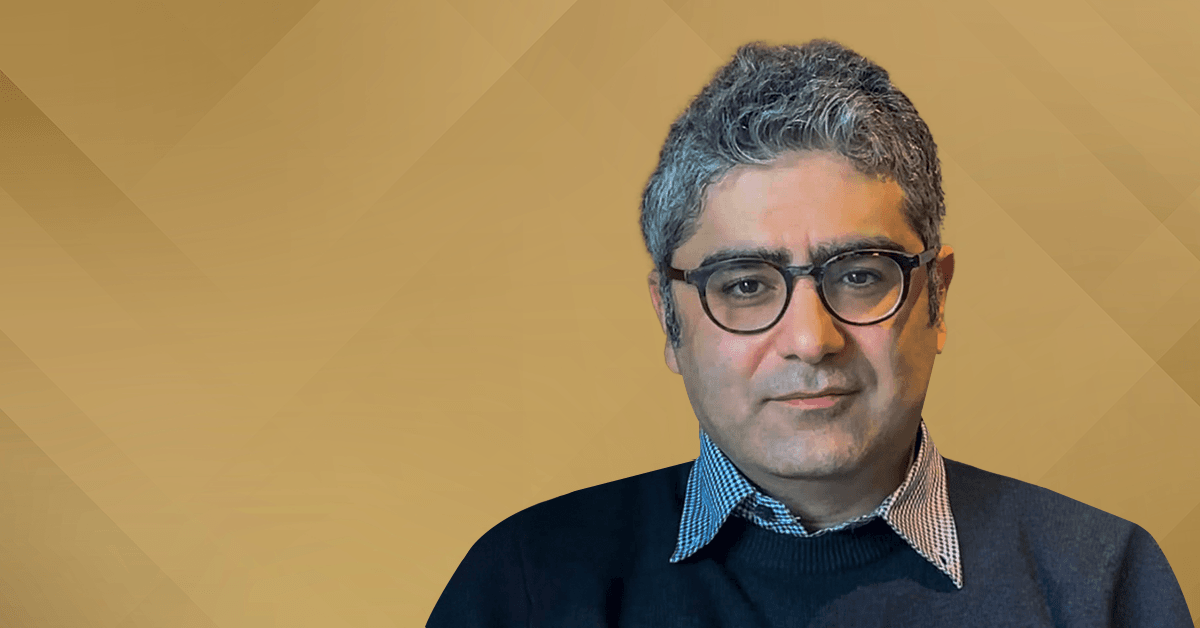In this interview, Dr. Payam shares his approach to high-resolution AFM imaging, the impact of open science on reproducibility, and future directions for nanomaterials research.

As part of an ongoing series here on ACS Axial, we’re interviewing authors and librarians from around the world to find out more about their research, their published work, and the impact that open science is having on a changing landscape of research communication. This time, we talked to Dr. Amir Farokh Payam, Senior Lecturer in Electronics and Software at the University of Ulster, United Kingdom.
Open access provides a very good opportunity for us to not only to share our results, but also to read the work of other researchers without any issues.

Hello, Dr. Payam. What can you tell us about your research group’s current focus?
My group's research focuses on two main areas:
- The first one is the theoretical and experimental development of atomic force microscopy techniques used in different kinds of studies—particularly semiconductors, nanomaterials, polymers and composites, and biological materials.
- The second area is design and development of micro-nanoscale resonators for sensing and characterization.
We currently have four main projects underway. Firstly, supported by the international exchange program of the Royal Society, we are working on nanomechanical quantification of cancer cells. The second project is light matter interaction in semiconductors, which is similar to the ACS Nano article we'll discuss soon. The third stream of research is the quantification of the mechanical properties of nanomaterials, including the development of new techniques and approaches.
The last one, which is supported by UKRI UK-Canada Quantum for Science Research Collaboration, focuses on the design and development of a quantum resonator for multiparametric sensing applications.
Could you give us a quick summary of the work in your paper, "Unravelling Spatio-temporal Transient Dynamics at Nanoscale via Wavelet Transform-based Kelvin Probe Force Microscopy"?
We developed a new paradigm for data acquisition and imaging for atomic force microscopy (AFM), based on wavelet transform. The standard approach in AFM uses a lock-in amplifier (LIA) to detect and image the amplitude and phase of a cantilever signal through the interaction with the sample that is being mapped. Each frequency that is being mapped requires a separate lock-in amplifier, which can make this approach complex from a hardware standpoint. We have applied our WT approach on Kelvin Probe Force Microscopy (KPFM) and use open-loop KPFM to eliminate the limitations of feedback system on the temporal resolution of our measurements. KPFM measures the surface charge of a sample, and with our method we can measure the capacitance gradient and dielectric constant of materials. There is a trade-off between temporal and spatial resolution using classic KPFM techniques.
The main advantage of our wavelet-based technique described in the paper is that it demonstrates through measurements and simulation how we can measure samples at the microsecond level with the outlook to go sub-microsecond, which provides a temporal resolution of three orders of magnitude higher than the lock-in constant. The article acts as a proof of principle for our methodology and demonstrates promise for detecting nanoscale charge dynamics, which could for example help optimize solar cells and other semiconductor applications.

Unraveling Spatiotemporal Transient Dynamics at the Nanoscale via Wavelet Transform-Based Kelvin Probe Force Microscopy
DOI: 10.1021/acsnano.3c06488
This was published in ACS Nano—what was the experience like?
My first experience of ACS Nano was when I was PhD student and postdoc researcher, and the groups I was working in, published papers there. I think ACS Nano is one of the top nanoscience journals—it's very prestigious, and I always follow the papers it publishes to see the recent developments in my field. I've always found the ACS Nano review process to be very fair and systematic. They have high editorial standards and a focus on good and impactful science.
The article was published in 2023—what kind of impact do you think it's had since then?
Since it was published, my colleagues and I have presented this work at multiple conferences, and we've received very good feedback each time—for example, suggestions about implementing our method for other semiconductor materials, and integrating with other spectroscopy techniques that can provide transient detection at higher temporal resolutions.
Although WT implementation to get multiple frequencies is simpler than LIAs, one of the limitations of the developed OL-WT-KPFM is that it's very technical, specific and requires quite an advanced laboratory setup with equipment that not everyone will have access to (mainly advanced AFM groups in the AFM community have access). That's something I am thinking about for future projects—how more labs can make use of the results without needing advanced instrumentation. The more labs can make use of the results in future, the bigger its impact will be.
Your article was published OA through the University of Ulster’s agreement with ACS—how did you discover this was available?
Each year my institution shares information with faculty about the publisher agreements we have, so I knew in advance that we have an agreement with ACS Publications. That's a really great opportunity, because it lets us publish our paper open access without needing to cover the charges ourselves, and that means readers can easily find and access the article.
I know how important this is, because when I was in different institutions for my undergraduate and graduate degrees, PhD, and postdoctoral placements we did not always have access to the papers we wanted to read. It can be a struggle, because when you want to read an article which looks to be important for your own research that you can't immediately access, your first step would be to email to the author. In some cases they'd have moved institute, and they wouldn’t see your email, or they're busy and don't follow up on requests. Open access provides a very good opportunity for us to not only to share our results, but also to read the work of other researchers without any issues.
It's really good that my institute has these agreements with ACS Publications and other publishers. There are some journals that are a priority for our group, like ACS Nano and knowing that we can publish open access there is great. It means we can get a broad readership and publish in priority journals. Some research funders provide funding for open access as part of their grants, which is useful if institutions cannot provide agreements with all publishers. Through the combination of grant funding and institutional agreements, I think authors have lots of opportunities to make their work accessible to as many people as possible.
What are your thoughts on the concept of open access?
The concept of open access in science is perfect. Before the internet, you can imagine how long publishing results took, and how few people had access to those results because you needed to have access to a physical copy of a journal or book.
Now the internet is everywhere and open access means that experts and non-experts alike can have access to science—and it's the real mission of science to provide everyone with the opportunity to understand how the world works.
Open access also shows how important the methodology and data for research are in being able to replicate a study and show that it's correct. The more open access to research there is, the more opportunities there are for reproducibility. It also allows for more AI training and access, which is going to be very important for the future.
There is a potential danger that sometimes the data for a paper is hidden, maybe because the article or the underlying data are not open access, which limits how comprehensively the AI can be trained and have access to the new data. There may also be some bias in the data which is not picked up on if the data is not open access. This is another opportunity with OA and open science—being able to build up a community and conversation around research, like you might find on social media. People can come and comment on the research, and provide their critiques.
What do you think are the biggest recent developments in open science and open access?
There are two big developments. Firstly, preprint services like arXiv—I think these are a very good option. In some cases, the peer review process can take a very long time—sometimes you submit to a journal, then after review it gets transferred to another journal or you choose to submit somewhere else, and it can take many months from submission to when it is published.
Preprints mean that you can get that feedback quicker and have a version of your research available to the public even sooner.
Secondly, I've seen some journals provide transparent peer reviews. They include the peer reviewer comments, and the authors' responses, and the editor's as well. Sometimes the reviewers are named and sometimes they are not; I don't have a clear idea about which way is best, because being named means that reviewers may need to be conservative about what they write, but it may also cause some potential reviewers do not want to review the papers at all as they prefer animosity. At the end I think it's important that people can discuss the work together and show how that discussion improves the final article.
Where do you see OA in 10 years' time?
I think that in ten years we will have more journals and publishers supporting open access, maybe to the point that everything is OA. Also, like I said before, I think more transparent peer review will also lead us to the next step of being able to gather critique from readers. Personally, I like to see more discussions and critiques about my works that helps me to not only enhance the quality of my research but also gives me more ideas to complete and continue that work.
I would like publishing to be a more active process, with paper as the center of a discussion between authors, reviewers, editors, and readers, and with AI to help check for reproducibility. If everything is open access, I think we can get there.
What do you think you'd be doing if you weren't a researcher?
I think I would be a movie director. When I was doing my bachelor's degree, I also made a short movie with my friends. As engineering students almost none of them really knew about editing scenes or shots in different ways and I just knew that from reading the film magazines. I believe that to be a good movie director, you need to have knowledge across many different fields and be highly innovative in order to bring the ideas in your mind to life on camera. In this sense, I see a strong similarity between scientists and artists in general—and movie directors in particular. After that I looked into studying movie-making, but decided to take my masters in Electrical and Electronic Engineering instead, and moved on to a PhD and focused on science. Sometimes I wrote reviews of movies in my native language, but after I became a lecturer I was so busy that I no longer had the time.
